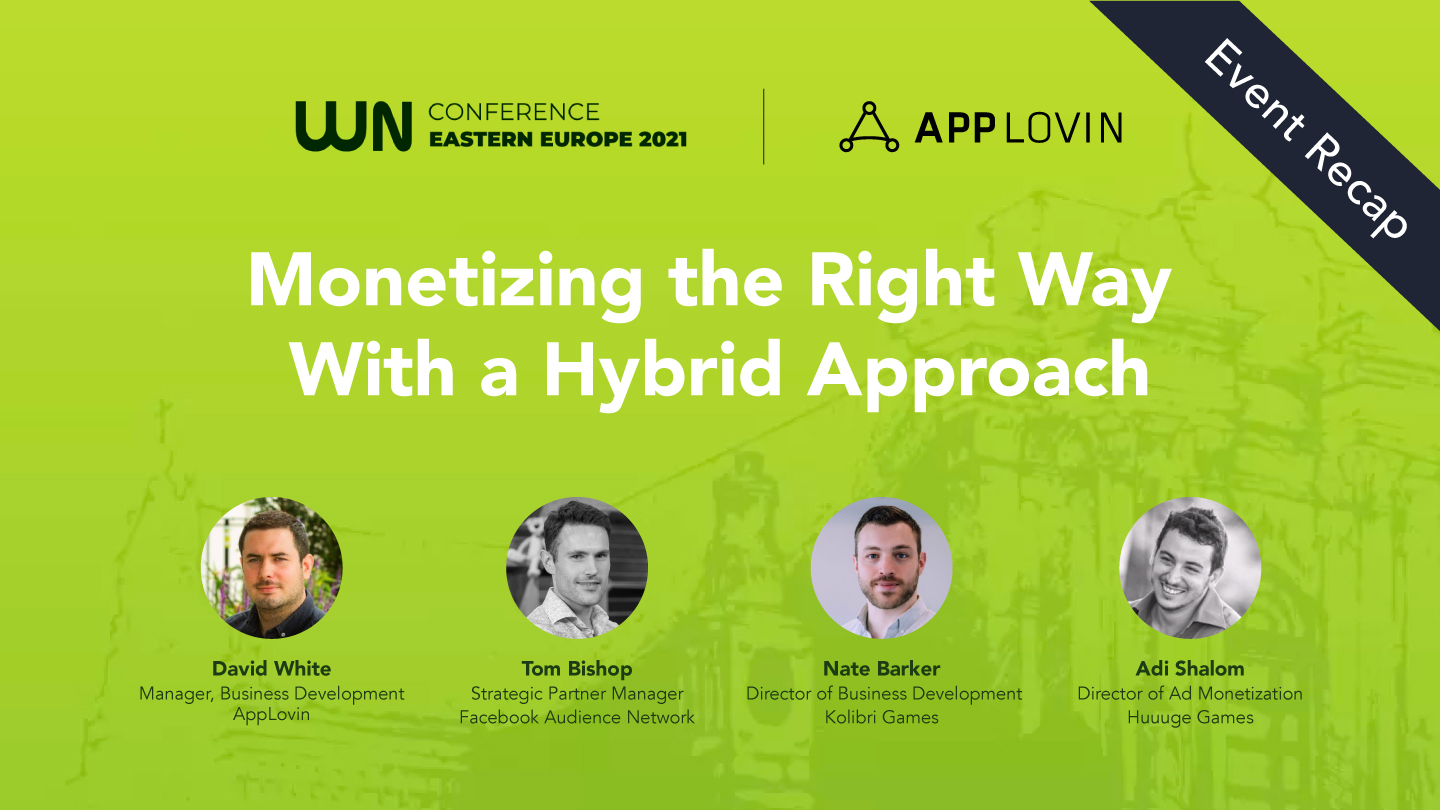Monetization
3 Key Takeaways for How to Monetize Your Apps With a Hybrid Approach
Jul 26, 2021

Monetization

AppLovin hosted a panel about how to improve your monetization with a hybrid approach at White Nights Eastern Europe 2021.
The virtual event was moderated by David White, Manager of Business Development at AppLovin, the panelists included Tom Bishop, Strategic Partner Manager at Facebook Audience Network, Nate Barker, Director of Business Development at Kolibri Games, and Adi Shalom, Director of Ad Monetization at Huuuge Games.
The group talked about the best ways to improve your monetization if you’re using in-app purchases (IAP) or in-app ads (IAA)—or a hybrid method.
Kolibri Games has historically focused on idle games, so their monetization strategy revolves mostly around in-app ads monetization. Huuuge Games makes all different genres of games, so they implement both in-app advertising and in-app purchases.
To provide context around these two studios, they both implement IAA and IAP. Kolibri Games has historically focused on idle games with equal focus on IAA and IAP. Huuuge Games makes all different genres of games that are mostly IAP-focused with a sophisticated integration strategy for IAA depending on the game.
Here are three key takeaways from their in-depth conversation.
The group agreed that it can be tricky to implement IAP without hurting your IAA. Keeping close tabs on the data helps Adi’s team at Huuuge Games to avoid competition with their ads and IAPs. They use a lot of rewarded videos to keep their users engaged.
Kolibri’s fans wanted a way to advance faster through the games, so the team added IAA as a way to facilitate that. They implemented AppLovin’s in-app bidder, MAX, and Nate said they saw a 25 percent lift on their revenue on day zero of their ad ROAS campaign. They were able to run IAP and ad ROAS campaigns simultaneously without having them compete against each other. Because of their partnership with AppLovin, they were able to easily cross-promote their other titles.
These days, players expect to see ads in a game, but bombarding them may cause retention rates to drop and potentially hurt LTV.
Engaging with ads in a holistic way—with concepts that relate back to the game provides opportunities for studios to get creative.
Understanding the user provides a foundation for creating the best user experience. These include looking at metrics across the board, including star ratings, reviews from app stores, and feedback channels between community management and product teams.
When it comes to ad revenue, Nate’s team looks at the total amount which is important for A/B testing. They also look at average revenue per daily user (ARPDAU) and effective cost per mille (eCPM) for performance because these metrics help optimize the network side.
They also keep track of the number of ads watched per daily active user and engagement percentages. This gives them a clearer idea of how many ads users should be watching per day and how many they should watch within their lifetime usage of the app.
For Huuuge, their ad experience is customized. For example, they control how frequently ads are shown to paying vs. non-paying users and don’t show as many ads to paying users. They also implement a lot of rewarded videos to keep both audience segments engaged.
If you’re not taking advantage of IAA and only focused on IAP, you’re leaving potential revenue on the table because you’re not able to reinvest that revenue into your UA. If you’re only using IAA, consider introducing new features to increase retention and balance your ad frequency to get the most out of your ad monetization as quickly as possible.
Understanding the flow of users that move through the game is an important part of learning about their motivation for when they want to see ads. Kolibri tests their ads a lot earlier when launching new titles and measures a certain percentage of ad engagement metrics rather than revenue metrics. Nate explained, “Later on, when we scale, we look at CPI and LTV and then optimize other metrics, but in the beginning, the focus is all about engagement.”
You can also test to find out how these balances impact performance. For example, you may lower the ad frequency and find your ad revenue will go down, but your LTV goes up.
Incrementally test with a small segment of your audience. If you only use IAP, you may consider showing 1 percent of your users an ad and then scale up to 5 percent. Then, measure the results.
Strengthening both your IAP and IAA are important parts of your overall advertising strategy. If executed well, you can improve your IAP as well.
Learn more about monetization and how Huuuge Games and Kolibri Games continue finding success in their hybrid-monetization approach and watch the full video.